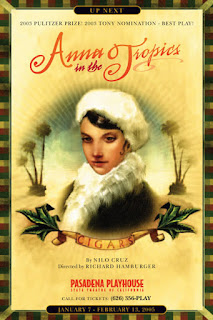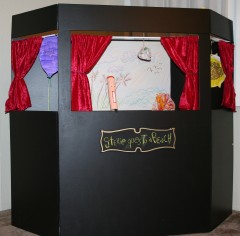The moment I stepped inside the theatre I knew I was in a totally different environment. On Friday the 22nd of October, I made way to Daytona State College for a showing of Anna in the Tropics, a play about the lives of Cuban immigrants who brought the cigar industry to Florida and how a romantic novel changed their lives forever. Entering the theatre the first thing I noticed was the stage, set up to face the audience. The seating for us, the audience, was nothing I could have foreseen, with three separate sections with a maximum of fifty seats each, rising up to overlook the stage. While it may have been small for some viewer’s taste, I felt at home as well as close to the actors as I could ever be. The vibe I felt from the fellow audience members gave me a sense that they were there to be entertained, not by each other but by the actors onstage who gave their time and skill for the production. As people waited and anticipated the beginning of the program there was chatter between them.
 As soon as the lights dimmed, there was silence, showing the convention that the audience should, if not must, show respect to the performers. Throughout the performance the audience as a whole made sure to keep the silence as if it promised the cast beforehand. While the majority of the crowd had paid noticed to the habit of silencing, or at least setting their cell phones to vibrate, some had forgotten, possibly being too anxious for the play to start. During the show, the occasional phone would noise off, creating a temporary interruption for the audience, some even turning towards the sound’s location to glare. The performers however, ignored the potential interruptions altogether and continued to give their all for those still showing attention and respect.
As soon as the lights dimmed, there was silence, showing the convention that the audience should, if not must, show respect to the performers. Throughout the performance the audience as a whole made sure to keep the silence as if it promised the cast beforehand. While the majority of the crowd had paid noticed to the habit of silencing, or at least setting their cell phones to vibrate, some had forgotten, possibly being too anxious for the play to start. During the show, the occasional phone would noise off, creating a temporary interruption for the audience, some even turning towards the sound’s location to glare. The performers however, ignored the potential interruptions altogether and continued to give their all for those still showing attention and respect. All through the play of Anna in the Tropics, several conventions were shown through the actions of the audience. After each scene, the audience as a whole was obliged, as they should be, to clap or applaud for the recent performers. The actors too have conventions, some easier to point out than others, and example being that they would all bow together, and then individually, once the play had finished. As they did this, we as a whole would cheer and clap for them, showing our support and appreciation for their talents. Everything on both sides of the event shown nothing out of the ordinary, overall I wasn’t treated to many surprises but I did witness a great example of improv, an unrehearsed action or expression.
I came to the play alone, however I discussed with fellow attendees about the performance. This is my favorite part, seeing what others have learned from the same event as me, often times being something totally unrelated. When you might believe that the murder of the lector in the performance was due to shear hatred, another witnesses could see it as an act of fate tying the lives of the characters even closer.
Felner, Mira, and Claudia Orenstein. The World of Theatre - Traditional and Innovation.
first. Boston MA: Pearson Education, Inc., 2006. 458. Print.





